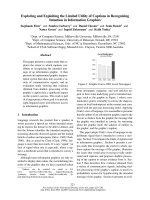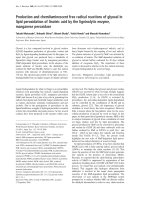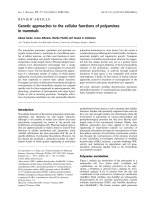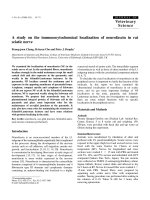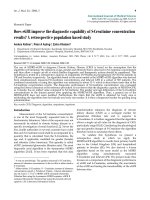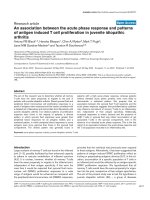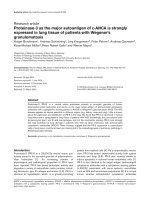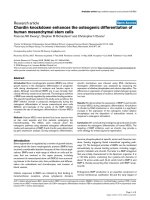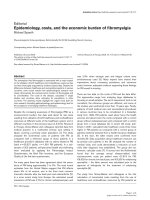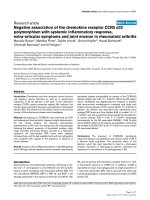Báo cáo y học: " ‘Relation, association, attribution …’ – the multiple faces of death in critical care medicine" pps
Bạn đang xem bản rút gọn của tài liệu. Xem và tải ngay bản đầy đủ của tài liệu tại đây (45.41 KB, 2 trang )
Available online />Page 1 of 2
(page number not for citation purposes)
Abstract
Mortality is one of the most important quality markers in critical
care, and there have been many epidemiological studies trying to
identify risk factors to better understand the mechanisms leading
to death in this complex disease. One of the major problems is that
there are multiple factors contributing to fatal outcome of septic
patients, and it is difficult to distinguish between those that are
independent from the acute disease (comorbidities and ‘risk
factors’) and those that are directly involved in the patho-
mechanisms of sepsis, thus leading to the ‘sepsis-attributable’
mortality. In this short commentary, some examples of different
approaches of how to analyze data on mortality are presented.
Easy to detect, but difficult to interpret – a simple approach
to one of the most important quality markers in critical care
medicine: mortality. In a recent issue of Critical Care, this was
impressively demonstrated by Melamed and Sorvillo [1], who
analyzed a huge multiple-cause-of-death (MCOD) database
in the US with the aim of investigating factors affecting
mortality in septic patients. The investigators showed that
there are numerous disparities between patients, and these
have to be considered when mortality rates are interpreted.
Gender, age, and ethnicity are factors that have considerable
influence on the outcome of septic patients, and crude
mortality over time differs from age-adjusted values. More-
over, the authors conclude that the epidemiology of sepsis
should be studied individually in racial/ethnic minorities so as
to elucidate unique features in each group [1].
Although these results – on first view – may not be that
surprising since there are a couple of studies showing similar
results regarding the effect of confounding factors like
gender and age on the mortality of sepsis [2], the paper of
Melamed and Sorvillo [1] is another important contribution to
improving our understanding of why septic patients die and
how time-dependent the developments are [3]. However, is
this approach clear and well defined? In terms of methods of
how data were analyzed, definitely yes! Limitations due to the
structure of the database were thoroughly discussed by the
investigators, and conclusions were critically reviewed with
respect to existing literature. But there is another aspect that
should be pointed out by this short commentary: the way that
‘sepsis-related’ and/or ‘sepsis-associated’ mortality is
defined. Relation and association are not very precise
attributes; they simply consider that the death of a patient has
something to do with sepsis. There are two major approaches
of how these ‘crude’ data can be analyzed to give a clearer
picture of the complex mechanisms in severe sepsis and to
allow us to conclude what might be the reasons why septic
patients do not survive.
The ‘multiple-cause-of-death’ analysis is one of these ways,
and actually it is the method with which most epidemiological
studies in septic patients are designed. The aim is always to
assess, by different statistical methods such as multiple
logistic regressions or propensity scoring, the risk factors that
affect the outcome of septic patients. The other way is much
more difficult: it tries to describe how mortality of critically ill
patients is influenced by the fact that they are septic. These
forms of analyses are rarely found in the literature, although
terms like ‘sepsis-attributed’ or ‘sepsis-attributable’ or
‘excess’ mortality are often used. However, the attributable
mortality in general defines the mortality directly associated
with sepsis and apart from the mortality attributable to
underlying conditions. A simple example: to analyze whether
obesity per se is a risk factor for dying in an intensive care
unit (ICU), investigators would have to perform a matched
case control study that compared patients with similar
course, but without obesity. Using this method, Bercault and
colleagues [4] demonstrated that obesity is an independent
Commentary
‘Relation, association, attribution …’ – the multiple faces of
death in critical care medicine
Susanne Toussaint and Herwig Gerlach
Department of Anesthesia, Intensive Care Medicine, and Pain Management, Vivantes – Klinikum Neukölln, Rudower Strasse 48, D-12313 Berlin,
Germany
Corresponding author: Herwig Gerlach,
Published: 29 April 2009 Critical Care 2009, 13:138 (doi:10.1186/cc7789)
This article is online at />© 2009 BioMed Central Ltd
See related research by Melamed and Sorvillo, />ARF = acute renal failure; ICU = intensive care unit.
Critical Care Vol 13 No 2 Toussaint and Gerlach
Page 2 of 2
(page number not for citation purposes)
risk factor for mortality in the ICU. Not only comorbidities, but
also events may be analyzed such as shown by Classen and
colleagues [5], who proved that adverse drug events are
associated with a significantly prolonged length of stay,
increased economic burden, and an almost twofold increased
risk of death. Two other examples: in women younger than
65, influenza was shown to increase mortality substantially
[6], and critically ill patients with liver cirrhosis suffering from
additional acute renal failure (ARF) have a mortality of 65%,
and those without ARF have a mortality 32% [7] (that is, the
‘excess mortality’ of ARF in this subgroup is roughly 33%).
In regard to infections, some studies demonstrate what is
generally expected: candidemia in hospitalized patients is
associated with excess mortality rates of 10.0% in children
and 14.5% in adults [8]. Other studies report a candidemia-
associated excess risk to die in hospital of 19% to 24% [9].
In the ICU, catheter-related infections have been analyzed
showing contradictory results, either with a significant excess
mortality (24.6%) from a study in Argentina [10] or with just a
trend after adjustment of other severity factors from a study in
France [11]. Some studies have surprising results: Blot and
colleagues [12] demonstrated that nosocomial Escherichia
coli bacteremia in critically ill patients had no excess mortality
after adjustment for disease severity! Overall, nosocomial
bloodstream infections seem to be associated with an
intrinsic excess mortality. In critically ill HIV patients,
Tumbarello and colleagues [13] assessed a crude mortality of
43%, with an infection-associated excess mortality of 27%. A
similar rate of bloodstream infection-associated excess
mortality (28%) was described by Smith and colleagues [14]
in non-HIV patients. Probably one of the largest investigations
was presented by Pittet and colleagues [15], who found a
crude mortality of 50% in critically ill patients with infections
versus 15% without infections (that is, the attributable
mortality was 35%).
How are the results for sepsis or severe sepsis defined as
inflammatory response plus infection (plus organ dysfunction
in severe sepsis)? Very simple: unknown! So far, there are no
existing data that enable us to attribute an ‘excess mortality’
to sepsis, probably due to the fact that not only the complex
disease but also the difficult definition of sepsis prevents us
from separating crude from excess mortality. We should keep
this in mind when we try to interpret results from epi-
demiological studies on sepsis. Hopefully, extended statis-
tical methods and the use of large registries similar to the
presented database [1] will help us to overcome this burden
in the future.
Competing interests
The authors declare that they have no competing interests.
References
1. Melamed A, Sorvillo FJ: The burden of sepsis-associated mor-
tality in the United States from 1999 to 2005: an analysis of
multiple-cause-of-death data. Crit Care 2009, 13:R28.
2. Dombrovskiy VY, Martin AA, Sunderram J, Paz HL: Rapid
increase in hospitalization and mortality rates for severe
sepsis in the United States: a trend analysis from 1993 to
2003. Crit Care Med 2007, 35:1244-1250.
3. Christaki E, Opal SM: Is the mortality rate for septic shock
really decreasing? Curr Opin Crit Care 2008, 14:580-586.
4. Bercault N, Boulain T, Kuteifan K, Wolf M, Runge I, Fleury JC:
Obesity-related excess mortality rate in an adult intensive
care unit: a risk-adjusted matched cohort study. Crit Care
Med 2004, 32:998-1003.
5. Classen DC, Pestotnik SL, Evans RS, Lloyd JF, Burke JP:
Adverse drug events in hospitalized patients: excess length
of stay, extra costs, and attributable mortality. JAMA 1997,
277:301-306.
6. Neuzil KM, Reed GW, Mitchel EF, Griffin MR: Influenza-associ-
ated morbidity and mortality in young and middle-aged
women. JAMA 1999, 281:901-907.
7. Du Cheyron D, Bouchet B, Parienti JJ, Ramakers M, Charbonneau
P: The attributable mortality of acute renal failure in critically
ill patients with liver cirrhosis. Intensive Care Med 2005, 31:
1693-1699.
8. Zaoutis TE, Argon J, Chu J, Berlin JA, Walsh TJ, Feudtner C: The
epidemiology and attributable outcomes of candidemia in
adults and children hospitalized in the United States: a
propensity analysis. Clin Infect Dis 2005, 41:1232-1239.
9. Morgan J, Meltzer MI, Plikaytis BD, Sofair AN, Huie-White S,
Wilcox S, Harrison LH, Seaberg EC, Hajjeh RA, Teutsch SM:
Excess mortality, hospital stay, and cost due to candidemia: a
case-control study using data from population-based can-
didemia surveillance. Infect Control Hosp Epidemiol 2005, 26:
540-547.
10. Rosenthal VD, Guzman S, Migone O, Crnich CJ: The attribut-
able costs, length of hospital stay, and mortality of central
line-associated bloodstream infection in intensive care
departments in Argentina: a prospective, matched analysis.
Am J Infect Control 2003, 31:475-480.
11. Soufir L, Timsit JF, Mahe C, Carlet J, Regnier B, Chevret S: Attrib-
utable morbidity and mortality of catheter-related septi-
caemia in critically ill patients: a matched, risk-adjusted,
cohort study. Infect Control Hosp Epidemiol 1999, 20:396-401.
12. Blot S, Vandewoude K, Hoste E, De Waele J, Kint K, Rosiers F,
Vogelaers D, Colardyn F: Absence of excess mortality in criti-
cally ill patients with nosocomial Escherichia coli bacteremia.
Infect Control Hosp Epidemiol 2003, 24:912-915.
13. Tumbarello M, Tacconelli E, Donati KG, Leone F, Morace G,
Cauda R, Ortona L: Nosocomial bloodstream infections in
HIV-infected patients: attributable mortality and extension of
hospital stay. J Acquir Immun Defic Syndr Hum Retrovirol 1998,
19:490-497.
14. Smith RL, Meixler SM, Simberkoff MS: Excess mortality in criti-
cally ill patients with nosocomial bloodstream infections.
Chest 1991, 100:164-167.
15. Pittet D, Tarara D, Wenzel RP: Nosocomial bloodstream infec-
tions in critically ill patients: excess length of stay, extra costs,
and attributable mortality. JAMA 1994, 271:1598-1601.
